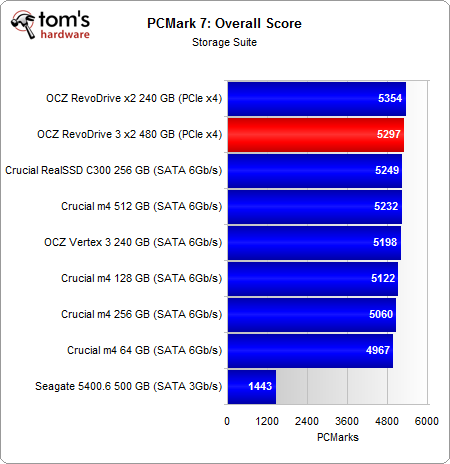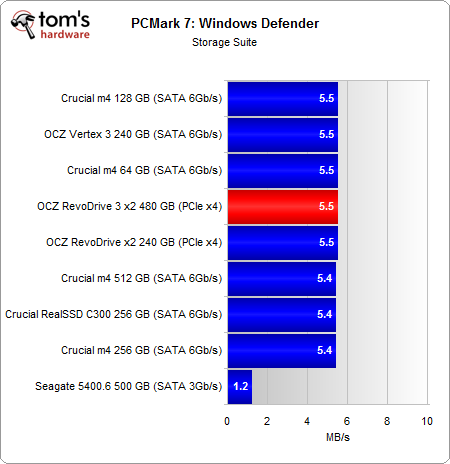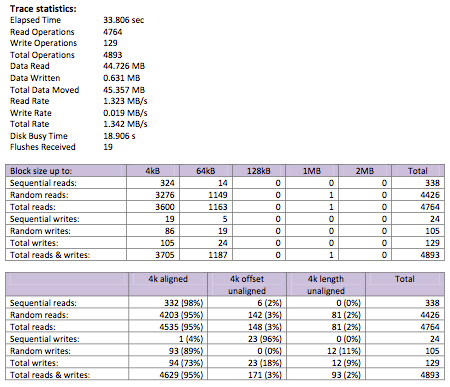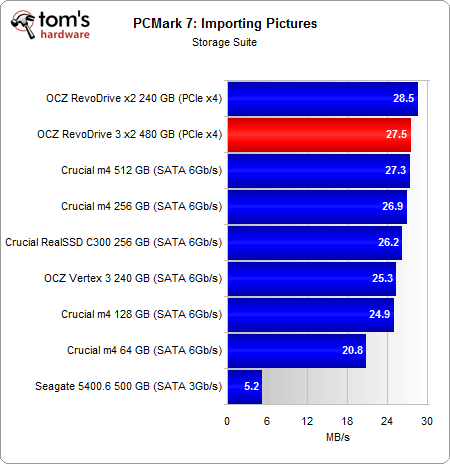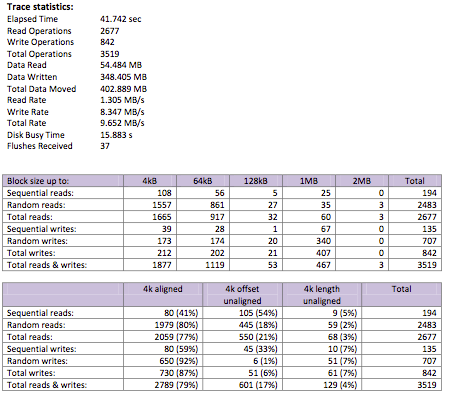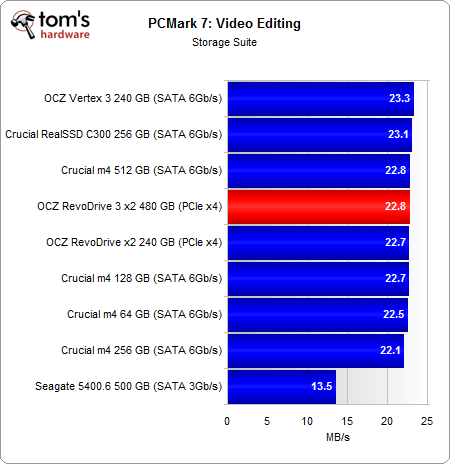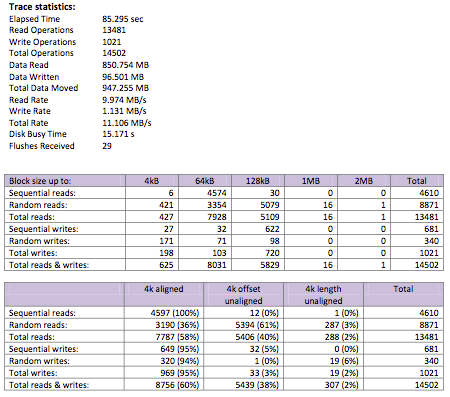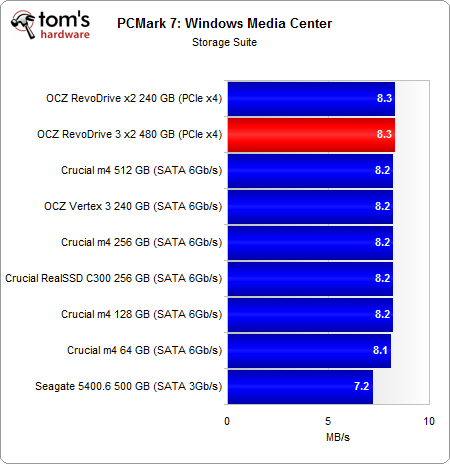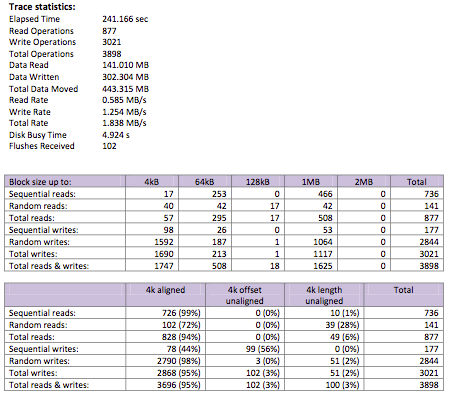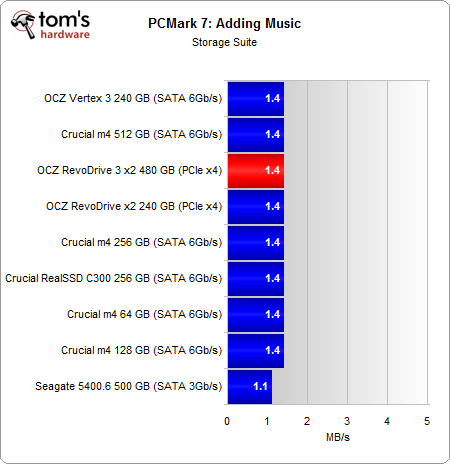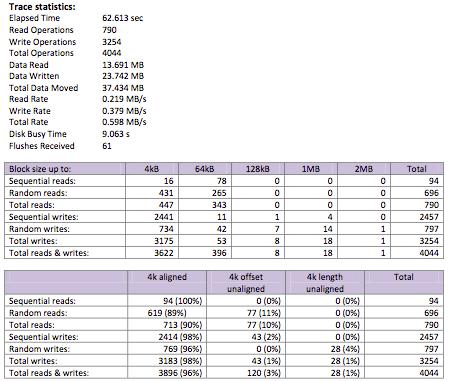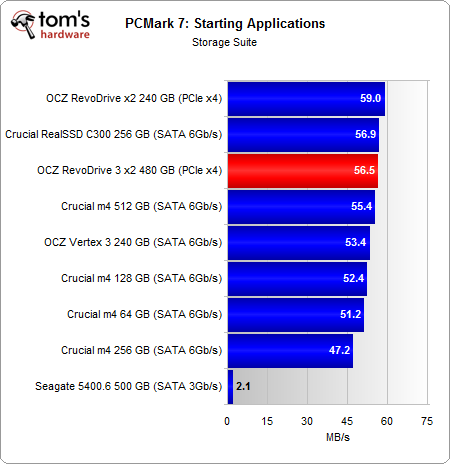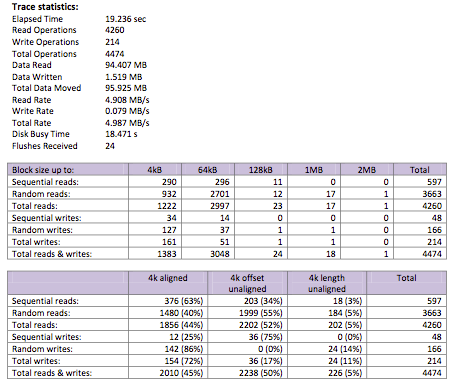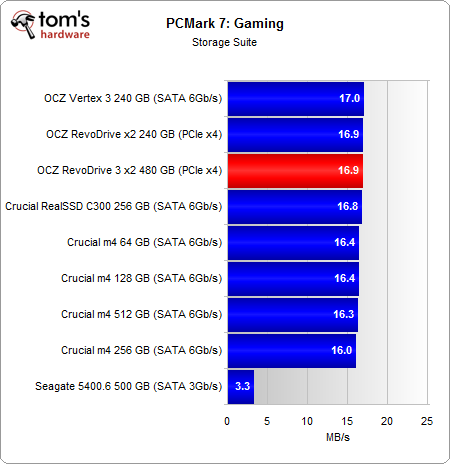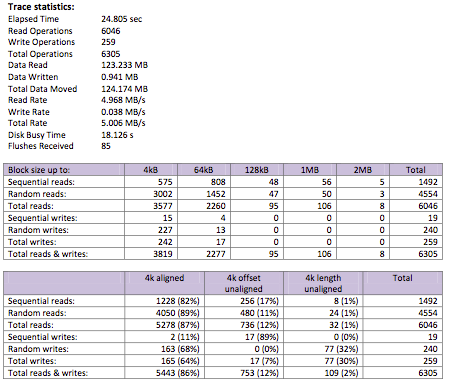The OCZ RevoDrive 3 X2 Preview: Second-Gen SandForce Goes PCIe
PCMark 7: Storage Suite
PCMark 7 is the latest synthetic from Futuremark, which we've been discussing with the company at various stages during its development process. Vantage gives a moderate approximation of storage performance, but there are situations where the scores vary too much from run to run to make us comfortable with it, particularly while testing SSDs. Frankly, Futuremark never designed PCMark Vantage to benchmark SSDs.
PCMark Vantage and 7 use the same underlying trace-based technology in Intel's Ipeak. But Futuremark's programmers made a few improvements in the latest version to improve accuracy, and fortunately, we don't see that crazy variability in PCMark 7.
Again, we see the margin of difference between SSDs is much smaller in PCMark 7, but it's important to remember that the overall storage score is based on a geometric mean of all the subtests. That's why it's important to take a deeper look into the individual tests.
The Windows Defender test is based on a trace of Windows' Defender performing a Quick Scan of the system. This is very random read-heavy scenario. In fact, read operations make up 97.9% of the trace, and of the read ops, 93% of them are random accesses. There are only a few real-world scenarios where this scenario applies:
- searching for files
- anti-virus scanning
Overall, there's no performance difference between all the SSDs. The 64 GB m4 performs just as fast as the RevoDrive 3 X2, which makes sense considering that we're only dealing with transferring 45 MBs. However, compared to a notebook hard drive, all SSDs offer about 4x the performance.
The second test in PCMark 7's storage suite is a trace based on importing 68 images (434 MB total) from a USB thumb drive into Windows Live Photo Gallery. This doesn't actually include copying the image files. The trace only includes the I/O activity pertaining to indexing. This type of scenario involves more writing more data than you read, but most of it occurs with random write accesses.
The RevoDrive X2 outpaces the RevoDrive 3 X2; this is mostly the result of the former having a superior random read speed at lower queue depths.
Get Tom's Hardware's best news and in-depth reviews, straight to your inbox.
The Video Editing test is a based on the I/O activity of a publishing a 1080p video in Windows Live Movie Maker. We're dealing specifically with a scenario where you're combining multiple high-def sources and writing them to a single output file. Overall, you're looking at a 30/70 split between random and sequential reads. Moreover, the reads are far more prevalent than the writes. In fact, the ratio is about 1:9 in favor of reads.
While the RevoDrive 3 X2 excels in sequential reads, this workload is particularly biased toward random reads access, which puts the drive at a disadvantage. The writing portion of this workload also isn't kind to OCZ's latest SSD, since writing the video file involves incompressible video data. The RevoDrive 3 X2's superior sequential read speeds help shore up some of the gap, but it's not enough to keep it at the top of the chart.
The Windows Media Center test is a based on a trace of a HTPC recording two simultaneous TV shows in Windows Media Center, while playing a separate prerecorded show. We're basically dealing with reading one file and writing two others. That's why the we're writing 2x data than we're reading (the video files share the same bit rate).
This type of scenario involves a lot of random writes (94%), because Windows Media Center incrementally adds data to the video file as the TV show progresses. Reads are another story, as they're almost all sequential (84%). Playing a video file is different than recording one; when you play a video file, you're loading it up and playing it back as a continuous stream.
In this scenario, there's conceivably very little difference between SSDs. Though, hard drive performance is still abysmal.
The Adding Music test in PCMark 7 is a not exactly what it sounds like. Futuremark hooked a drive filled with 68 GiB of music files (lossless WMA) to a computer and recorded the I/O activity while Windows Media Player added the audio tracks to the music library. The important point is that this doesn't actually involve copying files to the disk. We're only taking about scanning and indexing music files. You'd think that means more random reads and almost no writes, but indexing involves adding to a database of information. That's why we're dealing with more sequential writes (75% of all writes) and a situation where reads are outnumbered by writes by 2:1.
In this benchmark, we're presumably restricted by the low bus speed of the external disk with all of the music files.
The Starting Application trace is extremely brief in that it's only made up of loading the PCMark 7 Whitepaper v1.0 PDF and opening Internet Explorer from the taskbar (19.236 seconds). So, we're only dealing with reading a 717 KB PDF file and loading executables, along with related file dependencies from the system drive. The amount of data read outnumbers the amount written 63:1, and expectedly, most of the read accesses are random in nature (86% of all reads).
Most of the random read accesses occur with a queue depth between two and four, which helps explain why the RevoDrive X2 leads the pack. The RevoDrive 3 X2 still performs well, but it's hindered by the lack of large sequential transfers.
The Gaming test involves starting and loading World of Warcaft, which is why we're dealing almost exclusively with reads. Most of the read operations are random in nature, but in terms of the total amount of data read, there's a fairly even split between sequential and random accesses. Even though there are 3002 random reads and 575 sequential reads with block sizes up to 4 KB, this cumulatively only accounts for less than 14 MB of the total 123 MB read. At block sizes between 1 and 2 MB, there are more sequential reads than there are random reads.
The margin of difference is much smaller than the Starting Applications test, so it's difficult to make any comment on performance. Of course, there's still a clear line in the sand between SSD and HDD performance.
Current page: PCMark 7: Storage Suite
Prev Page Sequential Performance Versus Transfer Size Next Page Final Words-
warmon6 ReplyIt's not a business-class product. It's for the power user who is able to tax it using the right workload. If you're not one of those folks, the RevoDrive 3 X2 is seriously overkill.
OVERKILL?!?!
Nothing is overkill in the computer arena in terms of performance. :p
Just the price can be over kill. o.0 -
acku Santa is going to need a bigger expense account... :)Reply
Personally, I'm hoping that OCZ adds TRIM prior to September.
Cheers,
Andrew Ku
TomsHardware.com -
greenrider02 I saw defense of the Vertex 3's occasional low numbers, but no mention of the solid (and sometimes better) performance that the cheaper and more miserly Crucial m4 showed throughout your tests.Reply
Perhaps you have some bias towards the Vertex 3 that needs reconsideration?
Other than that, $700 seems like a fair price when considering the performace difference, especially if utilized properly, for instance as a high traffic web/corporate server -
acku greenrider02I saw defense of the Vertex 3's occasional low numbers, but no mention of the solid (and sometimes better) performance that the cheaper and more miserly Crucial m4 showed throughout your tests.Perhaps you have some bias towards the Vertex 3 that needs reconsideration?Other than that, $700 seems like a fair price when considering the performace difference, especially if utilized properly, for instance as a high traffic web/corporate serverReply
If you read the first page then you know that I give a nod to Vertex 3s as the fastest MLC based 2.5" SSD. I consider that plenty of love. :).
We'll discuss the lower capacity m4s in another article. FYI, I suggest that you read page 5 and page 6. We are not testing FOB. We are testing steady state. That's part of the reason the SF-based drives are behaving differently with incompressible data.
On your second point, this is in no way targeted toward an enterprise environment (that's what Z-drives are for). There is no redundancy in the array if a single SF controller fails. The whole card is a dud afterward. You can add higher level redundancy, but enterprise customers have so far been nervous on SandForce products. Plus, there's a general preference for hardware vs. software redundancy. (That's them talking not me). Overall, this makes it unacceptable for any enterprise class workload.
